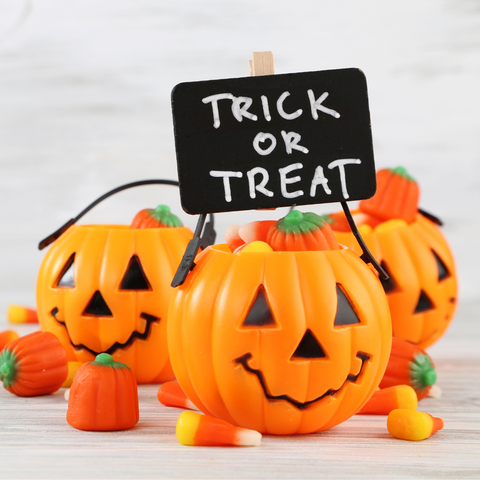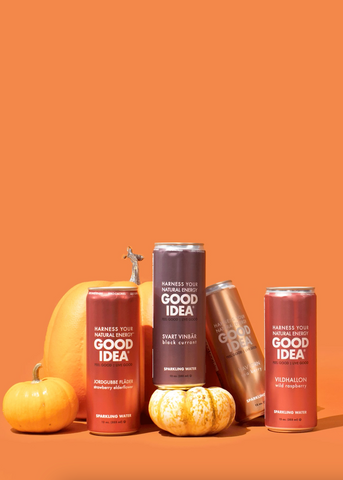4 Ways to Trick or Treat without Spooking Your Blood Sugar

🎧 On the go? Listen to this episode on The GOOD IDEA Audio Blog, available on Shopify or Apple Podcasts.
Halloween kicks off the festive season with plenty of fun and everyone’s favorite candies. It is easy to raid the kid’s Halloween loot or snack on the leftover candy. Plus, all those miniature bags make us feel justified in eating two, three, or more candies at once. This is an easy way to rack up the sugar (and calories) at the beginning of the holiday season. While everyone deserves a little indulgence now and again, here are a few tips on how to treat yourself while minimizing the impact on your blood sugar.
1. Eat Sweets Last

As kids, how many times were we told not to eat dessert first? In our younger years, all we wanted to do was go straight to the sweets. However, there is solid scientific evidence showing that mom was right (again). Meal sequencing is the order in which you eat your food. This order significantly impacts how our food is processed within the body. When you eat candy on an empty stomach the high sugar content provides a quick source of fuel for the body. It spikes your blood sugar and then quickly overcompensates by having your blood sugar take a nosedive about 1-2 hours after your snack. This phenomenon is called reactive hypoglycemia and can impact your mood (hungry and irritable) and start you on a blood sugar roller-coaster that can be challenging to manage.
A simple way to reduce the likelihood of reactive hypoglycemia is to reduce the magnitude of the initial glucose spike. Consuming proteins and/or fat before carbohydrates promotes the release of a hormone (glucagon-like peptide-1) that slows gastric emptying and reduces insulin and glucagon. By slowing gastric emptying glucagon-like peptide-1 (GLP-1) allows glucose to enter the bloodstream at a more manageable rate, as opposed to the quick sugar dump that would be experienced after eating a Twix on an empty stomach.
Consuming high-fiber foods before your favorite Halloween snack has also been shown to significantly reduce postprandial blood glucose. However, fiber acts on blood sugar independently of the hormone GLP-1. Thus, by consuming fiber with protein and/or fat we can work to lower blood sugar from multiple angles. Saving sweets until the end of a healthy meal will minimize the glucose spike, have you feeling full longer, and reduce the likelihood of binge-snacking due to sudden food cravings from low blood sugar.
2. Put Your Candy to use Post-workout

Turn a sweet treat into a performance boost by eating your candy of choice post-workout with a high-protein snack/shake. It is common to see athletes drinking a protein shake after a workout. Protein helps to build muscle and recover for the next training session. Adding simple carbohydrates (like the glucose and fructose found in many candies) to your post-workout protein is also beneficial for recovery. Carbohydrates after a workout help to restore glycogen stores, a stored form of glucose that is a backup fuel used for high-intensity exercise. Restoring glycogen quickly is especially important for individuals with two high-intensity workouts on the same day or tournament-style play with back-to-back competitions.
Another benefit to your post-workout chocolate bar is that consuming carbohydrates with your protein (in a 2:1 to 4:1 ratio, depending on your workout duration and intensity) can enhance the efficacy of your protein shake. While it might not be the best idea to consume all of these post-workout carbohydrates in candy form (it’s a lot of fat), stashing a few mini-Snickers bars in your gym bag every once in a while can be an effective way to refuel.
3. Take Your Snack on the Move

Exercising after eating, or eating your candy during your workout (cue the Reese’s on the treadmill), will help to utilize some of that glucose to fuel your exercise and reduce the likelihood of reactive hyperglycemia. Carbohydrates provide a fast fuel source that is used to power high-intensity exercise like repeated sprints, intervals, or sustained challenging efforts. For this reason, many athletes take high-carbohydrate snacks with them to fuel longer (over 75 minutes), high-intensity workouts. While candy won’t pack the same nutritional punch as some other options, feel free to add a sweet treat into the mix during the holiday season. As a word of caution, choose a snack that won’t melt in your pocket as you crush your exercise goals. Think about prioritizing candy corn or skittles over chocolate.
4. Drink a GOOD IDEA

If you’re headed to a party or plan on indulging this spooky season, grab a GOOD IDEA. Drink 1/3 of a can before you eat and finish the can with your food to reduce post-meal blood sugar by an average of 25%. This blood sugar reduction is due to a unique blend of five amino acids and chromium picolinate. The amino acids (leucine, isoleucine, valine, threonine and lysine) and chromium work together to synergistically increase insulin sensitivity and reduce post-meal blood sugar by an average of 25%. This allows the body to more effectively transport energy into the cells, use our food as fuel, and stabilize our blood glucose levels.
Whether your go-to indulgence is a Snickers, KitKat, or Laffy Taffy, a few tricks can help you keep your treats and keep your holiday season full of joy (or Almond Joys). Happy Halloween!
Author: Dr. Colleen Gulick



